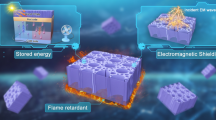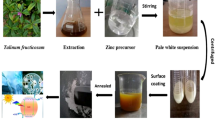Abstract
The aim of this paper is to characterize the microrelief and wettability of lotus leaf, waterlily leaf and biomimic ZnO surface with potential engineering applications. The characterizations of morphologies reveal that the top surface of lotus leaf is textured with 4 μm–10 μm size protrusions and 70 nm–100 nm nanorods, while the top surface of waterlily leaf is textured with wrinkle and decorated with concave coin-shaped geometric structure. The wettabilities of water and oil on lotus leaf and waterlily leaf under different surroundings were systematically researched. It is indeed interesting that the leaves of the two typical plants both living in the aquatic habitats possess opposite wettabilities: superhydrophobicity for top surface of lotus leaf (156°) while quasi-superhydrophilicity for top surface of waterlily leaf (15°). We have succeeded in fabricating the superhy-drophobic ZnO nanorods semiconductor material (151°) employing a simple method inspired by the detailed structures and chemical composition of lotus leaf.
Similar content being viewed by others
References
Wang B, Liang W X, Guo Z G, Liu W M. Biomimetic super-lyophobic and super-lyophilic materials applied for oil/water separation: A new strategy beyond nature. Chemical Society Reviews, 2015, 44, 336–361.
Guo Z G, Zhou F, Hao J C, Liu W M. Stable Biomimetic super-hydrophobic engineering materials. Journal of the American Chemical Society, 2005, 127, 15670–15671.
Wang G Y, Guo Z G, Liu W M. Interfacial effects of super-hydrophobic plant surfaces: A review. Journal of Bionic Engineering, 2014, 11, 325–345.
Xin Y, Guo Z G. Robust superhydrophobic zinc oxide film. Chemistry Letters, 2014, 43, 305–306.
Zhao Y J, Gu H C, Xie Z Y, Shum H C, Wang B P, Gu Z Z. Bioinspired multifunctional janus particles for droplet manipulation. Journal of the American Chemical Society, 2013, 135, 54–57.
Heng X, Xiang M M, Lu Z H, Luo C. Branched ZnO wire structures for water collection inspired by cacti. ACS Applied Materials Interfaces, 2014, 6, 8032–8041.
Dong Y, Li J, Shi L, Wang X B, Guo Z G, Liu W M. Underwater superoleophobic graphene oxide coated meshes for the separation of oil and water. Chemical Communications, 2014, 50, 5586–5589.
Wang H and Guo Z G. Design of underwater superoleopho-bic TiOb2 coatings with additional photo-induced self-cleaning properties by one-step route bio-inspired from fish scales. Applied Physics Letters, 2014, 104, 183703.
Guo Z G, Liu W M, Su B L. Why so strong for the lotus leaf? Applied Physics Letters, 2008, 93, 201909.
Barthlott W, Neinhuis C. Purity of the sacred lotus, or escape from contamination in biological surfaces. Planta, 1997, 202, 1–8.
Zheng Z J, Wang M L, Wang D J, Duan W J, Wang X, Zheng C C. Preparative separation of alkaloids from Nelumbo nucifera leaves by conventional and pH-zone-refining counter-current chromatography. Journal of Chromatography B, 2010, 878, 1647–1651.
Ma C J, Wang J J, Chu H M, Zhang X X, Wang Z H, Wang H L, Li G. Purification and characterization of aporphine alkaloids from leaves of nelumbo nucifera gaertn and their effects on glucose consumption in 3T3-L1 Adipocytes. International Journal of Molecular Sciences, 2014, 15, 3481–3494.
Ren L Q, Wang S J, Tian X M, Han Z W, Yan L N, Qiu Z M. Non-smooth morphologies of typical plant leaf surfaces and their anti-adhesion effects. Journal of Bionic Engineering, 2007, 4, 33–40.
Extrand C W, Moon S I. Repellency of the lotus leaf: Contact angles, drop retention, and sliding angles. Langmuir, 2014, 30, 8791–8797.
Choi Y, Brugarolas T, Kang S M, Park B J, Kim B S, Lee C S, Lee D. Beauty of lotus is more than skin deep: Highly buoyant superhydrophobic films. ACS Applied Materials Interfaces, 2014, 6, 7009–7013.
Seymour R S, Schultze-Motel P. Thermoregulating lotus flowers. Nature, 1996, 383, 305.
Ensikat H J, Ditsche-Kuru P, Neinhuis C, Barthlott W. Superhydrophobicity in perfection: The outstanding properties of the lotus leaf. Beilstein Journal Nanotechnology, 2011, 2, 152–161.
Purkayastha M D, Kalita D, Das V K, Mahanta C L, Thakur A J, Chaudhuri M K. Effects of L-ascorbic acid addition on micro-filtered coconut water: Preliminary quality prediction study using 1H-NMR, FTIR and GC-MS. Innovative Food Science & Emerging Technologies, 2012, 13, 184–199.
Dean J A. Lange’s Handbook of Chemistry (15th ed.), McGraw-Hill Press, New York, USA, 1998.
Nowicka E, Hofmann J P, Parker S F, Sankar M, Lari G M, Kondrat S A, Knight D W, Bethell D, Weckhuysenb B M, Hutchings G J. In situ spectroscopic investigation of oxidative dehydrogenation and disproportionation of benzyl alcohol. Physical Chemistry Chemical Physics, 2013, 15, 12147–12155.
Norwood M J, Louchouarn P, Kuo L J, Harvey O R. Characterization and biodegradation of water-soluble biomarkers and organic carbon extracted from low temperature chars. Organic Geochemistry, 2013, 56, 111–119.
Chen C M, Huang J Q, Zhang Q, Gong W Z, Yang Q H, Wang M Z, Yang Y G. Annealing a graphene oxide film to produce a free standing high conductive graphene film. Carbon, 2012, 50, 659–667.
Wagner C D, Riggs W M, Davis L E, Moulder J F. HandBook of X-ray Photoelectron Spectroscopy. Perkin-Elmer Corporation, Eden Prairie, 1979.
Naumkin A V, Kraut-Vass A, Gaarenstroom S W, Powell C J, NIST X-ray Photoelectron Spectroscopy Database 20, [2012], http://srdata.nist.gov/xps/Default.aspx.
Kowa K W, Yusoff R, Abdul Aziz A R, Abdullah E C. From bamboo leaf to aerogel: Preparation of water glass as a precursor. Journal of Non-Crystalline Solids, 2014, 386, 76–84.
Sait H H, Hussain A, Salema A A, Ani F N. Pyrolysis and combustion kinetics of date palm biomass using thermo-gravimetric analysis. Bioresource Technology, 2012, 118, 382–389.
Yang H P, Yan R, Chen H P, Zheng C G, Lee D H, Zheng C G. In-depth investigation of biomass pyrolysis based on three major components: Hemicelluloses, cellulose and lig-nin. Energy Fuels, 2006, 20, 388–393.
Gao W H, Chen K F, Xiang Z Y, Yang F, Zeng J, Li J, Yang R D, Rao G H, Tao H. Kinetic study on pyrolysis of tobacco residues from the cigarette industry. Industrial Crops and Products, 2013, 44, 152–157.
Varhegyi G, Chen H G, Godoy S. Thermal decomposition of wheat, oat, barley and brassica carinata straws: A kinetic study. Engergy Fuels, 2009, 23, 646–652.
Singh D P, Singh J P. Enhanced evaporation of sessile water droplet on vertically standing Ag nanorods film. The Journal of Physical Chemistry C, 2011, 115, 11914–11919.
McGuiggan P M, Grave D A, Wallace J S, Cheng S F, Prosperetti A, Robbins M O. Dynamics of a disturbed sessile drop measured by atomic force microscopy (AFM). Lang-muir, 2011, 27, 11966–11972.
Guo Z G, Liu W M. Biomimic from the superhydrophobic plant leaves in nature: Binary structure and unitary structure. Plant Science, 2007, 172, 1103–1112.
Chu Q W, Liang J, Hao J C. Facile fabrication of a robust super-hydrophobic surface on magnesium alloy. Colloids and Surfaces A: Physicochemical and Engineering Aspects, 2014, 443, 118–122.
Ge J, Ye Y D, Yao H B, Zhu X, Wang X, Wu L, Wang J L, Ding H, Yong N, He L H, Yu S H. Pumping through porous hydrophobic/oleophilic materials: an alternative technology for oil spill remediation. Angewandte Chemie International Edition, 2014, 53, 3612–3616.
Zhu X T, Zhang Z Z, Men X H, Yang J, Wang K, Xu X H, Zhou X Y, Xue Q J. Robust superhydrophobic surfaces with mechanical durability and easy repairability. Journal of Materials Chemistry, 2011, 21, 15793–15797.
Zhang J, Liu Y R, Wei Z Y, Zhang J Y. Mechanism for wettability alteration of ZnO nanorod arrays via thermal annealing in vacuum and air. Applied Surface Science, 2013, 265, 363–368.
Tian D L, Zhang X F, Tian Y, Wu Y, Wang X, Zhai J, Jiang L. Photo-induced wateroil separation based on switchable superhydrophobicity-superhydrophilicity and underwater superoleophobicity of the aligned ZnO nanorod array-coated mesh films. Journal of Materials Chemistry, 2012, 22, 19652–19657.
Ilegbusi O J, Song H W, Chakrabarti R. Biocompatibility and conductometric property of solgel derived ZnO/PVP nanocomposite biosensor film. Journal of Bionic Engineering, 2010, 7, S30–S35.
Ivanova T, Harizanova A, Koutzarova T, Vertruyen B, Facile deposition of ZnO:Cu films: Structural and optical characterization, Materials Science in Semiconductor Processing, 2015, 30, 561–570.
Deng R, Yao B, Li Y F, Li B H, Zhang Z Z, Zhao H F, Zhang J Y, Zhao D X, Shen D Z, Fan X W, Yang L L, Zhao Q X. Surface morphology, structural and optical properties of polar and non-polar ZnO thin films: A comparative study. Journal of Crystal Growth, 2009, 311, 4398–4401.
Li X B, Ma S Y, Li F M, Yang F C, Liu J, Zhang X L, Zhao Q, Yang X H, Wang C Y, Zhu J, Zhu C T, Wang X. Blue-green and red luminescence from non-polar ZnO: Pb films. Applied Surface Science, 2013, 270, 467–472.
Young T. An essay on the cohesion of fluids. Philosophical Transactions of the Royal Society of London, 1805, 95, 65–87.
Wenzel R N. Resistance of solid surfaces to wetting by water. Industrial and Engineering Chemistry, 1936, 28, 988–994.
Wang B, Zhang Y B, Shi L, Li J, Guo Z G. Advances in the theory of superhydrophobic surfaces. Journal of Materials Chemistry, 2012, 22, 20112–20127.
Tie L, Guo Z G, Li W. Optimal design of superhydrophobic surfaces using a paraboloid microtexture. Journal of Colloid and Interface Science, 2014, 436, 19–28.
Author information
Authors and Affiliations
Corresponding author
Rights and permissions
About this article
Cite this article
Yang, F., Guo, Z. Characterization of Micro-Morphology and Wettability of Lotus Leaf, Waterlily Leaf and Biomimetic ZnO Surface. J Bionic Eng 12, 88–97 (2015). https://doi.org/10.1016/S1672-6529(14)60103-7
Published:
Issue Date:
DOI: https://doi.org/10.1016/S1672-6529(14)60103-7




